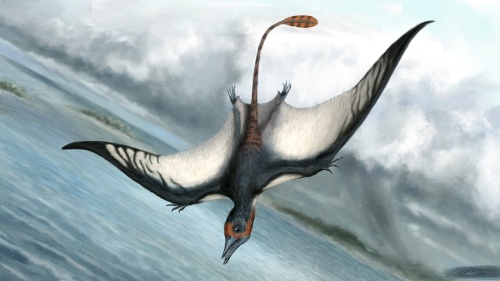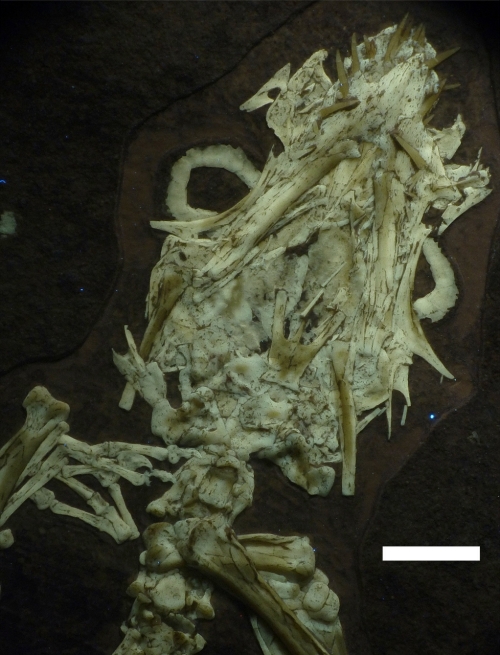
Last week I took a very brief trip to Germany to do a round of several museums and collect some data for various projects I am working on. As well as catching up with some old friends (human and fossil) I got to see some new ones (human and fossil). I’ve been filling in the pterosaurs over on Pterosaur.net (including this guy which is an absolute must-see) but here I thought it would be best to bring back Sciurumimus. This little theropod did make an appearance on here when first described, but now I have a couple of pictures of my own (the specimen is currently on display in the Solnhofen Museum) it seemed time to bring it back. So here’s a couple of additional images of this outstanding little theropod.
Posts Tagged 'Germany'
Berlin spirits
Published 09/05/2013 Uncategorized 3 CommentsTags: Berlin, curation, exhibition, Germany, museum
So a last look at some of what is on show in the new Berlin halls. These are a couple of shots of their new spirit room, a climate-controlled room to protect all of the various pickled specimens in jar upon glass jar that line the shelves. The Natural History Museum in London have also relatively recently renovated their spirit collection and moved it to not just a better environment for the material, but also opened it up to the public in a similar manner and the effect in both cases is superb.
These are parts of collections rarely seen by visitors to museums and they are difficult to display and are probably seen as something of a turn-off since it does tend to be lots of very bleached and slightly decayed bodies crammed unceremoniously into jars, and it’s often pretty tricky to tell what’s in there. However in both cases I think the point is less about exactly what is there, and more the “look at all this stuff” effect of the whole collection. You are there to see the forest, not the trees, and so it’s a demonstration of just what material and information is there and what this means for both the museum collections and science as a whole. When that is offset by the aesthetics of all that glass in a glass-fronted room and clever lighting, the effect is quite wonderful.
Visitors to the Solnhofen Museum in Germany in recent years might well have seen a delightful specimen of a small Rhamphorhynchus on display. While clearly a nice little find, it was hard to see too much detail under the glass given how a) small it was and b) just how close in colour the bones were to the matrix it was preserved in. Certainly I didn’t give it much more than a glance when I first saw it as part of the Flugsaurier fieldtrip way back in 2007, and I’m not sure that many of my colleagues did either (though to be fair we had only an hour or two to try and do the whole museum, and well, if you work on pterosaurs you generally have seen a lot of Rhamphorhynchus material).
However, while I was in Dublin, a PhD student working on Solnhofen jellyfish pointed me back to this as something worthy of more special interest. Once I had some decent photos of it, it was clear that it was indeed something rather more special than just a young and complete specimen of Rhamphorhynchus. Indeed, while clearly having a lot in common with this very well known genus, there were some obvious and pretty significant differences. Talking to the curator at the Solnhofen, Martin Roeper, I discovered that (perhaps inevitably) Helmut Tischlinger had already taken a number of UV images of the material and he and Dino Frey had planned to work on it, but things had fallen behind. A few more exchanges and I was generously offered the chance to lead the formal description of the material and write up this interesting find.
That paper has now been completed and indeed published, and as such the inconveniently labelled specimen BSP–1993–XVIII–2 should now be known as Bellubrunnus rothgaengeri. The species name honours Monica Rothgaenger who led the team that uncovered the material and donated it to the museum (note that while this has a BSPG number, it is on permanent loan to the Solnhofen). The generic name comes from the locality of the matieral, Brunn, and the Latin ‘bellus’ meaning beautiful. This is the beautiful one from Brunn, and well, as you can hopefully see, it really is a superb specimen. It’s effectively complete and articulated and preserved in ventral view. While it is indeed hard to make out too much detail under normal lighting conditions, under UV, the difference between bone and matrix is obvious in the extreme and the details quite apparent and with tiny and fragile parts like the sclerotic rings, the palate, the tarsals and prepubes being preserved. Sadly though, there’s no sign of a single jot of soft tissues anywhere, despite the superb (indeed, unusually good) preservation of the bones. The matrix around the bones has been prepared right down to help expose them and you can see the scrape marks of preparation tools around the specimen.
Happily for all fans of sci comms and outreachy things, the paper is in PLoS ONE (the latest in quite a series for pterosaur work this year it must be said) and so freely available. There is, inevitably, a lot to be said about this animal and while the paper IS freely available, I think that there is a good mine of interesting things here that help reveal ideas about pterosaur evolution and anatomy. And let’s face it, even with the best will in the world, it can be hard to fight through a long paper, and it’s rather easier to read a few blog posts. That said, obviously with the paper being freely available, if you do want more details and specifics and citations etc. then the paper should be the first place you look.
This post then is perhaps not so much more than a holding pattern while obviously showing off the material itself, and this superb life reconstruction by Matt van Rooijen (which is also in the paper and so available) whom I must thank for his superb efforts. I’m not going to try and spin this out too much, but there are some nice areas of interest about Bellubrunnus that can be easily separated from the rest and make nice short and self-contained posts, so I’ll try and do just that. We’ll start almost immediately with the most obvious question – what exactly is it?
Aurorazhdarcho – a Jurassic azhdarchoid
Published 02/11/2011 Pterosaurs 6 CommentsTags: Germany, Jurassic, Pterosaurs
 Just a short post on this little fellow. I don’t generally like blogging on new taxa as a lot of other people cover them and there’s generally not much that can be said from an outside perspective that’s not in the paper. I don’t have much to add in that respect here either, but this is a nice thing for me to see out as I’ve seen the specimen knocking around in Dino Frey’s office on a number of occasions over the last few years while being assured it would be described ‘soon’. Well, now it is out and Aurorazhdarcho is born.
Just a short post on this little fellow. I don’t generally like blogging on new taxa as a lot of other people cover them and there’s generally not much that can be said from an outside perspective that’s not in the paper. I don’t have much to add in that respect here either, but this is a nice thing for me to see out as I’ve seen the specimen knocking around in Dino Frey’s office on a number of occasions over the last few years while being assured it would be described ‘soon’. Well, now it is out and Aurorazhdarcho is born.
The specimen is obviously in superb condition (photos above and below lifted from Frey et al., 2011) though the head and neck are gone. Still, an impression remains on the sediment to show where they originally lay and given an idea of their original size and shape which is rather nice.
The most interesting thing though is the identification of this as member of the azhdarchoids. This most derived of pterosaur clades are otherwise known only from the Cretaceous, though a Jurassic origin is to be expected if (and for some, this is a big if) you accept that Germanodactylus is a dsungariptid and that this clade is the sister-taxon to the azhdarchoids. Certainly it has a few features that are unique to the group (that huge hindlimb for starters) and this identification looks good to me (though I have to confess I have yet to read the paper in full detail), though as ever with a specimen like this, the lack of a head is a real shame.
Frey, E., Meyer, C.A. & Tischlinger, H. 2011. The oldest azhdarchoid pterosaur from the Late Jurassic Solnhofen Limestone (Early Tithonian) of Southern Germany. Swiss Journal of Geosciences in press.
The fish of Feinsten
Published 14/12/2010 Museums etc. 7 CommentsTags: fish, Germany, palaeontology
I rarely delve outside of archosaurs on here for obvious reason but this simply had to be shared. When I was introduced to some of this collection in the back rooms of the Jura Museum in Eichstaett I was literally rendered speechless. (And really actually literally. Those who know me will recognise this as an achievement). I was then told that what I was looking at was the *less* good stuff. The best material was on display in the galleries. They weren’t kidding. Feinsten is a new site in the Solnhofen limestones and the fish it is yielding (sadly nothing but fish so far, and a lone small turtle) are truly incredible. Stomach contents, skin patterns, gut casts and a preservational fidelity greater than anything I have ever seen before. Enjoy a small sampling:









Recent Comments